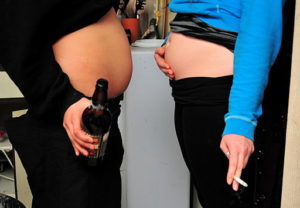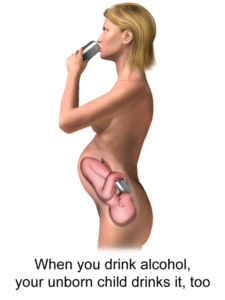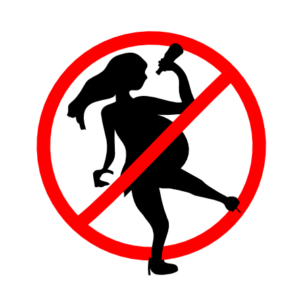One would assume that everyone knows smoking and drinking during pregnancy is a big no-no, and that most women likely hold off for the 9-month gestational period. For me personally, I was so paranoid that I refused to even taste wine and spit. Smoking and drinking during pregnancy can result in significant health problems for the developing fetus, including effects on physical growth, cognitive development, and behavior problems. While some of the damage caused by tobacco smoking during pregnancy can be reversed or at least treated, damage caused by alcohol consumption during pregnancy can result in irreversible conditions on the fetal alcohol spectrum and fetal alcohol syndrome.

Photo By Andrew Vargas (Flickr: motherly love) [CC BY 2.0 (http://creativecommons.org/licenses/by/2.0)], via Wikimedia Commons
A new study, published in the March 2018 issue of the academic journal Alcohol, aimed to use the hair testing method to objectively determine smoking and alcohol consumption during pregnancy, and to compare it to the same patient self-reports.
Brief Methods
153 pregnant women participated in this study. Participants carried singleton babies, with spontaneous births and with no complications. Participants all delivered at the Barcelona Center for Maternal Fetal and Neonatal Medicine at the Hospital Sant Joan de Déu and Hospital Clínic-Maternitat in Barcelona, Spain. After delivery, a 9-cm strand of hair was cut from participant’s heads.
The strands of hair were then process and tested (using mass spectrometry) for nicotine and cotinine to evaluate smoking history during pregnancy, and ethyl glucuronide for alcohol consumption history during pregnancy.
Additionally, participants underwent interviews to get their self-reported data on smoking and alcohol consumption during pregnancy.
Selected Results
- Participant demographics:
- 76.5% of participants were Spanish
- Mean age was 34.5 years (+/- 5.2 years)
- 35.3% had a college degree
- 18.9% had primary education only (i.e. less than high school)
- 51.6% had an unskilled job
- 45.1% had a skilled job
- Smoking in pregnancy:
- 28.1% of participants self-reported smoking during their pregnancy.
- There was no effect of maternal age on smoking during pregnancy.
- There were no socio-demographic differences between smokers and non-smokers during their pregnancies.
- Hair testing:
- 76.5% of participants did not smoke and were not exposed to smoke during their pregnancies.
- 16.3% of participants were non-smokers who were exposed to smoke in the environment (or were occasional smokers) during their pregnancies.
- 7.2% of participants were active smokers during their pregnancies.
- For active smokers, there was no correlation between nicotine and cotinine levels in hair and the number of cigarettes smoked per day.
- Alcohol consumption in pregnancy:

Photo By BruceBlaus (Own work) [CC BY 3.0 (http://creativecommons.org/licenses/by/3.0)], via Wikimedia Commons
- 2.6% of participants reported drinking alcohol during their pregnancy.
- Ethyl glucuronide in hair was associated with social class, with higher levels of the compound found in those with unskilled jobs compared to those with skilled jobs (i.e. those with unskilled jobs drank more during pregnancy).
- Hair testing:
- 35.3% of participants did not drink alcohol at any point during their pregnancies.
- 62.7% of participants consumed repeated moderate alcohol consumption during their pregnancies.
- 2% of participants consumed repeated heavy (“excessive”) alcohol consumption during their pregnancies.
- No correlation analysis could be performed on hair ethyl glucuronide levels and number of drinks consumed per day, as only 4 participants admitted drinking alcohol during their pregnancies.
- Smoking AND drinking during pregnancy:
- The only correlation between nicotine and ethyl glucuronide found was in active smokers, where it was found that they also were moderate to excessive drinkers.
Conclusions
Overall, the results of this study are rather alarming. According to these results, close to 2/3 of pregnant women participating in this study drink some amount of alcohol during their pregnancies. Interestingly, only 3% actually admitted to drinking alcohol during pregnancy. 3% and 65%-ish is a huge discrepancy. Why would so many women not report drinking alcohol during their pregnancies? Are they embarrassed? Afraid to have their children taken away from them? Think that a glass a day (or however much they were consuming) isn’t actually “drinking” in the social sense?
Of course, it is important to note that there are some limitations to this study, which could render the results applicable to only the study area. The big one that I will point out here is that there was a very small sample size used in this study. Only 153 women participated, most of whom were Spanish, so scaling the results up to a general populous of not only Spain but also globally, could be problematic. Perhaps there is something about this specific population that results in almost 2/3 of women drinking alcohol while pregnant, or maybe it is indicative of larger trends. The authors of the study claimed that their results were consistent with other similar studies in other places in Europe, so there is apparently some repeatability here.
Additionally, while these alarming results could be specific to just this one group or at least to greater trends in Europe, it should be noted that another recent study in the United States (click the link to see that study in the journal JAMA) found that fetal alcohol spectrum disorders are actually a lot more common than first thought, indicating that perhaps even here in the US, more women are consuming alcohol during pregnancy that we think, at least in some communities.

Photo courtesy Flickr user Chris Murtagh
The information gleaned from this study, coupled with the JAMA study that found the prevalence of fetal alcohol spectrum disorders in the US greater than we thought, should raise some red flags in terms of maternal education on the risks of alcohol consumption during pregnancy.
From a policy standpoint, since many more women avoided smoking during their pregnancies than drinking during this study, it appears campaigns to reduce smoking during pregnancy might be working, while campaigns to reduce (or eliminate) alcohol consumption during pregnancy either aren’t working or they are just non-existent in the study area. Perhaps more education and policy on the topics of both smoking and drinking during pregnancy would help reduce these numbers even further. Of course, these specific study results would be indicative of Spanish policy, but one could argue the need for more educational resources here in the US based on the JAMA study alone.
One certainly can not jump from these study results straight to policy and change, though the results are alarming and worthy of further, larger, studies in more areas around the globe.
…and when it comes to drinking while pregnant: don’t. Just dont.
Source:
The citation for the JAMA study referenced above:

2 comments for “Self-Reporting Versus Actual Alcohol Consumption During Pregnancy: Some Alarming Study Results”